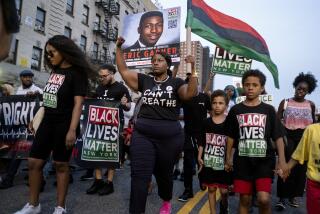Men’s Death Rate Higher in Harlem Than Bangladesh
- Share via
NEW YORK — Black men in Harlem are less likely to live to the age of 65 than men in Bangladesh, one of the world’s poorest nations, according to a study appearing today in the New England Journal of Medicine.
The study comparing the Manhattan neighborhood just north of Central Park with Bangladesh concluded that for women, overall survival to the age of 65 was somewhat better in Harlem, but only because the death rate among girls under 5 is very high in Bangladesh.
In that nation, the researchers said that 55% of men and 50% of women live to be 65. In Harlem, 40% of men and 65% of women reach 65 years of age.
“The situation in Harlem is extreme,” the report compiled by Drs. Colin McCord and Harold P. Freeman of Columbia University and Harlem Hospital said, “but it is not an isolated phenomenon. . . . Similar pockets of high mortality have been described in other U.S cities.”
“In recent decades, mortality rates have declined for both white and nonwhite Americans, but national averages obscure the extremely high mortality rates in many inner-city communities,” the researchers said. The high death rate in such areas deserves attention similar to that “given to natural disaster areas,” they said.
The researchers found that during the years of the study, from 1979 to 1981, there were 6,415 deaths in Harlem, where 96% of the population is black and 41% live below the poverty line. But if the death rate among U.S. whites had been applied to the community, there would have been only 3,994 deaths.
Cirrhosis, homicide, accidents, drug dependency and alcohol use were considered the most important underlying causes of death in 35% of all those under 65.
“An improvement in child mortality in Harlem between 1960 and 1980 was accompanied by rising mortality rates for persons between the ages of 25 and 65,” the article said. “There was, therefore, no improvement in overall age-adjusted mortality.”
In an interview, McCord, attending surgeon at Harlem Hospital, said he had worked in Bangladesh and that after seeing New York City death rate statistics he was not surprised at the findings.
“I think Americans have had the idea that things were improving for black people,” he said. But the study should dispel the notion that the gap between whites and blacks is narrowing, he said, noting that 650,000 people live in communities in New York where the death rate for those under 65 is twice the death rate for white Americans.
The article said that since 1980, the number of deaths among Harlem residents 25 to 44 years old had increased by 31% and AIDS had become the most common cause of death in this age group and in all of New York City.
McCord and Freeman stressed that action to correct “the appalling health conditions reflected in these statistics” need not wait for more research.
“The health care system is overloaded . . . and is poorly structured to support preventive measures, detect disease early and care for adults with chronic problems. At the same time, the population at highest risk has limited contact with the health care system except in emergencies.
” . . . New approaches must be developed to take preventive and therapeutic measures out of the hospitals, clinics, and emergency rooms and deliver them to the population at highest risk,” they said.
Times researcher Lisa Romaine contributed to this story.
More to Read
Sign up for Essential California
The most important California stories and recommendations in your inbox every morning.
You may occasionally receive promotional content from the Los Angeles Times.













